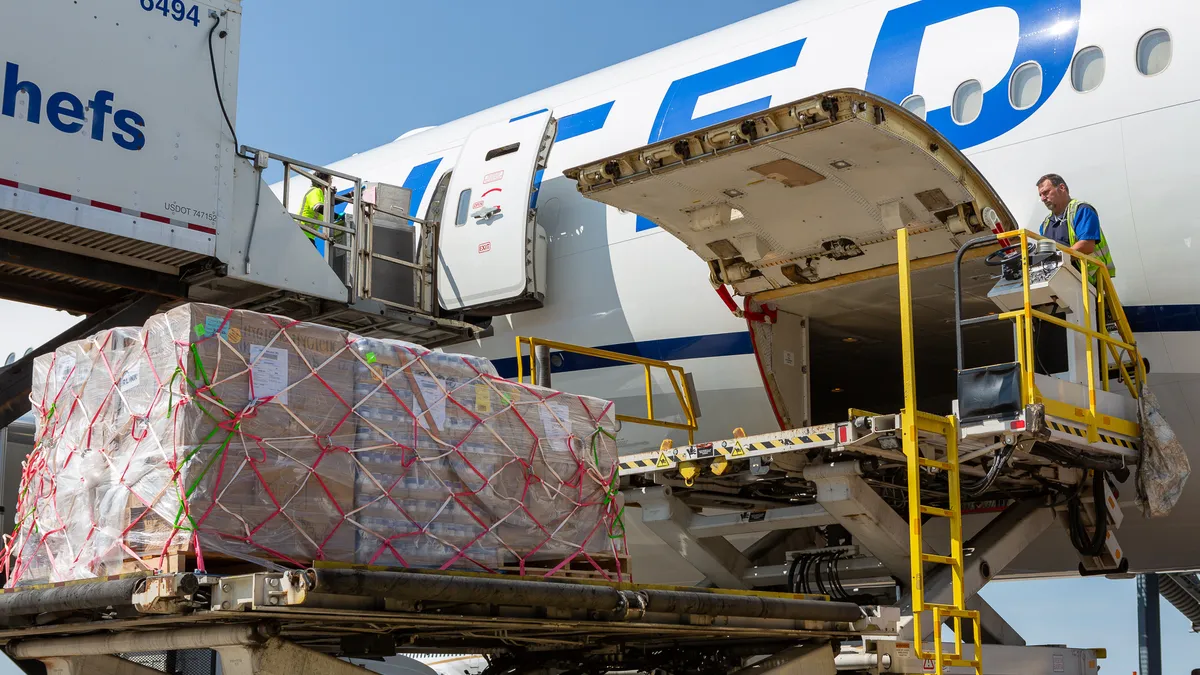Editor's Note: The following is a guest post by Ben Conwell, senior managing director and eCommerce Advisory Group practice leader at Cushman & Wakefield.
Back in the dark ages of commerce, delivery of anything across the country, let alone across an ocean, took weeks.
Who among us could have foreseen today’s consumer expectation of instant gratification? The e-commerce world as we know it is shrinking as consumers continue to purchase goods from outside the U.S. at a rapidly increasing rate. This shift will ultimately drive a change in the air freight industry. Where can air freight hubs expand? How will this impact industrial real estate and the supply chain?
Cross-border e-commerce today
By 2020, according to Accenture, over two billion consumers worldwide will be regularly shopping online, completing approximately 13.5% of total retail consumption online — a share approximately equal to U.S. domestic spending today. At over $3.4 trillion of gross merchandise value, global online sales are expected to grow at 14% per year over the next few years with no signs of slowing.
This while the share of global online consumption conducted cross-border is growing at an even faster rate. By 2020, U.S. retailers will sell nearly $485 billion in goods to the world and will buy $140 billion in goods directly from overseas sellers, according to Tompkins International. For context, these totals equal approximately 96% and 27% of projected 2018 total online retail spending in the U.S., respectively.
Historically, e-commerce orders have overwhelmingly flowed from Asia into the US and other western nations. The boom in cross-border e-commerce is rebalancing these flows whereby more goods that originate in the West are flowing into Asia.
With the increase of globalized e-commerce and consumer expectations for fast delivery, a two-plus week delivery proposition for maritime transit into the US just isn't competitive when many online retailers continue to expand next-day and same-day offerings. To satisfy this demand for faster delivery, a growing share of global direct-to-consumer shipping is shifting to air freight.
With that expansion will come burdens for shippers and their customers, but also opportunities for real estate investors, developers, and regional airports.
The current state of air freight
Global air freight volumes increased 9.1% in 2017, equal to two to three times the historical average, according to the International Air Transport Association (IATA). IATA attributes much of that increase to booming parcel deliveries. While the rate of increase in 2018 will likely come in somewhat lower, it is still expected to be above historical trends and well above the increase in global GDP.
Another indication of the coming surge in global air freight volumes is Boeing’s recent projection that growth in e-commerce trade, driven especially by international online retail sales, should drive demand for 2,480 new freighter aircraft over the next 20 years. Airbus projects comparable growth in demand in its Global Market Forecast, calling for a global freighter fleet increase of 65% over the next 20 years.
What better proof of the boom in air freight volumes in the years ahead is there than projected demand for additional aircraft capacity? The industry is anticipating the boom and building the capacity to move all those orders.
More planes equal a need for more pilots, but we are already facing an impending pilot shortage. To meet this increasing demand, Boeing predicts a need for 790,000 additional pilots by 2037. Airbus presents a similar prediction but with a slightly lower number of 450,000 pilots needed by 2035.
Current air cargo terminal situation
While demand for both inbound and outbound air cargo movements in the U.S. has never been higher, availability of warehouse and handling capacity at or near major legacy air cargo hubs has never been more scarce or expensive. Cargo congestion at John F. Kennedy International Airport (JFK) is a key example. While it typically takes 12 to 14 days for a container to cross the Pacific Ocean by ship, it takes just 14 to 18 hours for an airplane that is shipping containers of goods to move from landing at JFK to a truck hitting nearby freeways.
Availabilities in existing logistics buildings at mature cargo hubs such as JFK, Los Angeles International Airport (LAX), Miami International Airport, San Francisco International Airport (SFO), Chicago O’Hare International Airport (ORD), Newark Liberty International Airport, George Bush Intercontinental Airport in Houston, and even Dallas-Fort Worth International Airport (DFW) and Hartsfield-Jackson Atlanta International Airport (ATL) are at historic lows. Congestion at these airports is extremely costly and disruptive. More than half of the on-airport handling facilities at JFK are greater than 40 years old, according to Global Trade Magazine, and while the 26-acre on-airport warehouse development deal approved earlier this year by the Port Authority will help, it won’t solve the problem at JFK.
We’ve all felt the risk of missing a passenger flight due to traffic and congestion. The same kind of threat applies to cargo movements, but chances are there won’t be a flight for that cargo in the next hour. Delays at one place in the freight flow usually mean cascading delays, added costs and missed delivery promises.
In addition, freighters don't load and unload themselves, and it takes adequate handling facilities to keep deliveries moving accurately and on schedule. When considering the scarcity of available buildings at these legacy airports and the lack of developable sites close enough to runway aprons, opportunities are opening up elsewhere. Historically, leading U.S. air cargo hubs have a limited ability to expand their capacity to serve booming demand. This creates an opening for other airports to step up and for real estate opportunities at those alternative locations.
Opportunity ahead for alternative airports
In the face of terminal (excuse the pun), unresolvable congestion at legacy leading air cargo airports and permanent surging inbound and outbound flow, carriers and their customers will have to establish operations at alternative airports. Centers not thought of as leading air cargo facilities today that choose to invest strategically in building capacity inside and outside airport boundaries can create tremendous opportunities to attract surging demand in the future.
Among characteristics that can attract this business are:
- Runway lengths suitable for 747s and 767s
- Extensive on-apron handling facilities with room to expand
- Extensive availability of developable land for large logistics facilities within minutes of the airport
- Sufficiently low passenger volumes to ensure truck corridors can remain generally uncongested
- Short and predictable drayage distances
- Proximity to major freeway infrastructure
- Adequate and sustainable labor supply, including during peak seasons
- Generally moderate weather conditions, especially around peak periods to ensure low probability of weather disruptions to operations
Many of the prime (pun apology) candidates to become air cargo hubs of the future are among those where Amazon has established Amazon Air hubs. Similarly, UPS and FedEx have also invested in building capacity near a number of these potential major multi-service hubs. Cushman & Wakefield projects the following airports are among those well-suited to capitalize on this global cargo boom, provided authorities take proper action today to invest in required infrastructure:
- Columbus (CMH)
- Chicago - Rockford (RFD)
- Indianapolis (IND)
- Pittsburgh (PIT)
- Huntsville (HSV)
- Cincinnati (CVG)
- Salt Lake City (SLC)
- Mesa (AZA)
- Norton Air Force Base, San Bernardino (SBD)
- March Air Reserve Base, Riverside (RIV)
- Kansas City (MCI)
- Greenville/Spartanburg (GSP)
The real estate play
It is difficult to predict the amount of new logistics space that will be required to support the boom in cross-border air cargo.
Tompkins International projects the surge in cross-border air cargo tied significantly to global e-commerce may top 160 facilities averaging 800,000 square feet, plus smaller sortation and delivery spaces totaling 100 facilities ranging from 75,000 to 100,000 square feet. Quick math reveals that could be over 135 million square feet of new industrial space. That much supply can’t possibly fit in legacy cargo and distribution markets alone — much will land near the air cargo hubs of the future.
The coming boom in air cargo-related real estate demand is a seriously under-told story in our industry today. This is a long-term secular shift that we can expect to see building over the next five to 10 years. The runway ahead is long and profitable in many of these markets, and industrial investors and developers should prepare for take-off.





















